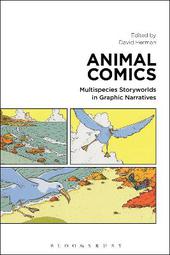
|
Animal Comics: Multispecies Storyworlds in Graphic Narratives
Hardback
Main Details
Description
Animal characters abound in graphic narratives ranging from Krazy Kat and Maus to WE3 and Terra Formars. Exploring these and other multispecies storyworlds presented in words and images, Animal Comics draws together work in comics studies, narrative theory, and cross-disciplinary research on animal environments and human-animal relationships to shed new light on comics and graphic novels in which animal agents play a significant role. At the same time, the volume's international team of contributors show how the distinctive structures and affordances of graphic narratives foreground key questions about trans-species entanglements in a more-than-human world. The writers/artists covered in the book include: Nick Abadzis, Adolpho Avril, Jeffrey Brown, Sue Coe, Matt Dembicki, Olivier Deprez, J. J. Grandville, George Herriman, Adam Hines, William Hogarth, Grant Morrison, Osamu Tezuka, Frank Quitely, Yu Sasuga, Charles M. Schultz, Art Spiegelman, Fiona Staples, Ken'ichi Tachibana, Brian K. Vaughan, and others.
Author Biography
David Herman has taught at several institutions in the US and, most recently, at Durham University, UK. Growing out of his recent studies on animal narratives across media, his monograph Narratology beyond the Human will be published in 2018.
ReviewsWith its international and interdisciplinary sweep, this ground-breaking volume examines the ways that comics activate animals as icons and symbols in ways that no other art form possibly can. * Bart Beaty, Professor of English, University of Calgary, Canada * If animals cannot speak, they have found in the authors of this fascinating volume the best advocates and interpreters. Animal comics are not a genre but a continent, of which the cartography is delivered here for the first time, in a truly cross-disciplinary perspective. * Thierry Groensteen, Cite internationale de la bande dessinee et de l'image, Angouleme, France * The essays offer a variety of critical frameworks for examining these comics; e.g., one essay provides a historical overview, with plenty of illustrative examples. Other contributors use a variety of theoretical lenses as they analyze these comics and even discuss animals in nonfiction comics. The final section (of four) should prove extremely helpful for teachers and future teachers: it offers strategies for using animal comics in various classroom settings, from a general education course to a young adult literature class. The variety of topics and texts represented here makes this collection useful across disciplines and interests ... The collection is a worthy complement to other books about graphic novels. Summing Up: Recommended. * CHOICE *
|